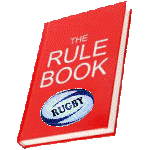Rugby
Rugby football developed from a version of football played at Rugby School and was originally one of several versions of football played at English public schools during the 19th century.
Rugby types
There are two distinctively different forms of rugby – rugby union and rugby league. Rugby union is both a professional and amateur game, administered by the International Rugby Board (IRB). Rugby league is also both a professional and amateur game, administered on a global level by the Rugby League International Federation.



Field:
Type of surface - it must be grass, sand, clay, snow or artificial grass.
Dimensions - The field of play does not exceed 100 metres in length and 70 metres in width. Each in-goal does not exceed 22 metres in length and 70 metres in width.
Lines on the playing enclosure - the line types are:
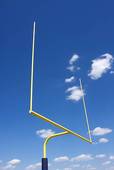
Goal post
Flag posts - There are 14 flag posts with flags. Each minimum height is 1.2 metres above the ground.
- solid - dead ball line, goal line, the 22-meters line, half way line and touchlines;
- dash - all lines other than solid lines are dash lines all of which are 5 metres in length. There are 5 and 10 meters dash lines;
- center - there is one line 0.5 metre long. It is the center of the half way line;

- The distance between the two goal posts is 5.6 metres;
- The crossbar is placed between the two goal posts. Its top edge is 3.0 metres from the ground
- It's height is 3.4 metres;
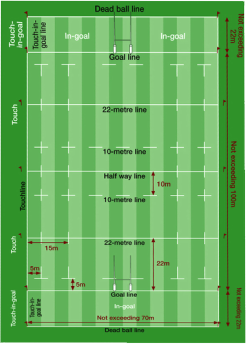
Equipment:
The Ball:
- shape - The ball must be oval and made of four panels;
- dimensions - Length in line: 280 - 300 mm; Circumference (end to end): 740 - 770 mm; Circumference (in width): 580 - 620 mm;
- weight - 410 - 460 grams




Players:
Teams - Rugby is a game played between two teams of 15 players;
Substitutions - With up to 7 substitutes allowed;


Equipment: - A player may wear supports, shin guards, ankle supports under socks, mitts, shoulder pads, mouth guard, headgear, bandages, thin tape or other similar material.



Duration of a match:
A match is divided into two halves each of forty minutes playing time;
One match is 80 minutes long, including time lost, extra time and any special conditions;
Half - time:
A team change it's end after each half-time;
a half-time is 15 minutes long;
Time lost - Time lost may be due to the following:
Injury;
Replacing players’ clothing;
Replacement and substitution of players;
Referee consulting with assistant referee(s) or other officials;




Every match is under the control of Match Officials who consist of the referee and two touch judges or assistant referees.

Referees:
Before the Match:
During the Match:
- Replacing the referee - If the referee is unable to complete the match, the referee’s replacement is appointed according to the instructions of the match organiser.
- Toss - The referee organises the toss. One of the captains tosses a coin and the other captain calls to see who wins the toss.
- The Duties - The referee keeps the time and the score. He gives permission - to the players to leave the playing area, to the replacements or substitutes to enter the playing area and to the team doctors or medically trained persons or their assistants to enter the playing area
- Consulting with others:
- The referee may consult with assistant referees, .
- The official may be consulted if the referee is unsure when making a decision in in-goal with regard to the scoring of a try or a touch down when foul play in in-goal may have been involved.
- The Referee's whistle - The referee must carry a whistle and blow the whistle to indicate the beginning and end of each half of the match ot stop play at any time;
- The refereee and injury - If the referee stops play because a player has been injured, and there has been no infringement and the ball has not been made dead, play restarts with a scrum.
Touch Judge and Assistant referees - Assistant referees are appointed by the union in charge of the fixture. They are either themselves qualified referees or qualified assistant referees. Assistant referees may be asked to help with duties that touch judges cannot. Touch judges are normally supplied by the teams playing, one from each team.
Additional persons - When a reserve touch judge or assistant referee is appointed, the referee’s authority
regarding replacements and substitutions may be delegated to the reserve touch judge or
reserve assistant referee
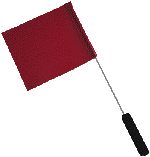



Playing a match:
A match is started by a kick-off;
After the kick-off, any player who is onside may take the ball and run with it;
Any player may throw it or kick it;
Any player may give the ball to another player;
Any player may tackle, hold or push an opponent holding the ball;
Any player may fall on the ball;
Any player may take part in a scrum, ruck, maul or lineout;
Any player may ground the ball in in-goal;
A ball carrier may hand-off an opponent;
Whatever a player does must be in accordance with the Laws of the Game;

The team currently with the ball moves it up the field toward his opponent’s goal line or to try for a dropped goal. These are the only two ways a team can score in ‘open play’.
In moving the ball up the field, the team with possession meets with the defending team who wish to:
- stop their opponent’s progress;
- take control of the ball (A ‘turn over’);
- attack the other goal.
- violates the Laws of the game – a foul;
- the ball moves off the field of play – into touch;
- a try or goal is scored.



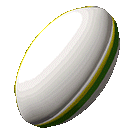
- Long kick-off;
- Short kick-off;
- Kick to around opposition 22;
- Kick to the side where the forwards are massed;
- Kick to the less defended side;
- be in their own 22 metre area or in-goal area;
- catch the ball cleanly;
- call "MARK!" at the same time as the catch is made
- not be catching after a kick start/restart from the centre of the field.



If the game stops because a rule has been broken, play restarts with either:
- touch and line-out:
- touch - When a player puts the ball into touch (that is, out of the field of play), the opposing team is awarded a line-out. An exception is that if the ball is kicked into touch from a penalty kick, the team that was awarded the penalty throws in to the resulting line-out;
- line-out - A line-out is formed with a minimum of two players from each side;


- a scrum - it is formed by the players who are designated forwards binding together in three rows. The First Row i compoed from two Props and the Hooker. At the Second Row are two Locks. Behind them (3th row) are 2 Flankers and Number 8;
- penalty kick and free kick - usually awarded to a team for a technical offence committed by the opposing side. There are four options - to play a place kick; a drop kick; a punt or to play a tap kick.



Points are scored by either scoring a try or a goal. A try is only scored when the player takes the ball across the goal line and grounds the ball. Grounding happens when the ball is on the ground and the player’s hand is on the ball. This ‘try’ is worth 5 points.
A goal is scored by kicking the ball between the uprights and above the crossbar of the goal posts. There are three ways to score a goal:
A goal is scored by kicking the ball between the uprights and above the crossbar of the goal posts. There are three ways to score a goal:
- a dropped goal;
- a penalty goal;
- a conversion by either a drop kick or a place kick. A penalty or dropped goal is worth 3 points; a conversion is worth 2 points.






